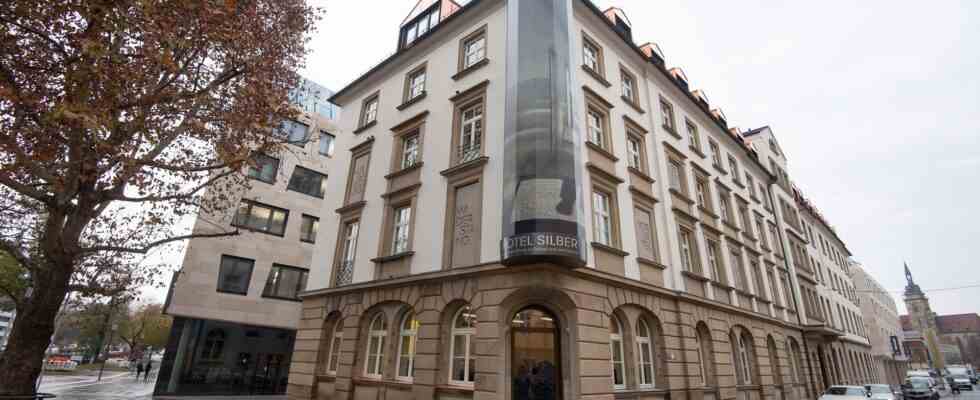Status: 01/27/2023 12:43 p.m
The Nazi regime arrested, tortured and murdered tens of thousands of homosexuals. In Stuttgart, the “Hotel Silber” stands for horror. The Gestapo headquarters were here during the Nazi era, today it is a place of remembrance.
“Arrest, surveillance, denunciation”: Anyone standing in front of the “Hotel Silber” in the middle of downtown Stuttgart will immediately notice these words. They adorn the facade of the historic building and are a reminder. Because the house has a long history. Originally built as a hotel, it housed the Stuttgart Police Headquarters and the State Political Police from 1928 – and from 1936 the Secret State Police, the Gestapo.
“It was an authority,” explains Friedemann Rincke, the curator of today’s “Hotel Silber, a place of remembrance.” “You can still see that today in the room structure: a long corridor with small rooms on the right and left. That’s where the clerks sat.” And decided about life and death.
Thousands were arrested, interrogated and tortured here during the Nazi era. Also many men for violations of paragraph 175, the “gay paragraph”. One of them is Albert Fendel, born in 1904. In 1940 he was taken into “preventive police custody” in Stuttgart and then deported to the Dachau concentration camp. Because he loved a man.
Terrorist Instruments of National Socialism
A cell door in the exhibition room of the “Hotel Silber” gives an idea of how prisoners like Albert Fendel must have fared after their arrest. The door is covered with names, numbers and symbols, carved by the prisoners hoping to leave a mark and not disappear entirely.
“The political police and the Gestapo were one of the very central instruments of power and terror of National Socialism, so that terrible suffering emanated from this place for tens of thousands of people, up to and including abuse here on site,” says Rincke. “There were a few cells in the basement, from which we have many reports – from abuse to murders by Gestapo officials shortly before the end of the Second World War.”
Criminalization started much earlier
The criminalization of homosexuals began much earlier. In 1872, Article 175 came into force, criminalizing sexual acts between men. But from 1933, under the Nazis, the persecution of homosexuals took on a new quality, reports Albert Knoll, archivist at the Dachau concentration camp memorial and author of the book “Der Rosa-Winkel-Gedenkstein”.
“In any case, there was an enormous increase in persecution from 1933 onwards. In the German Reich, around 1,000 people per year were sentenced under Paragraph 175 – and after that it exploded,” says Knoll. “Of course, the National Socialist state also wanted National Socialist people and homosexual men didn’t fit in there.”
Former Gestapo headquarters “Hotel Silber” is a memorial for Nazi crimes against homosexuals
Jenni Rieger, SWR, daily news at 12:00 p.m., January 27, 2023
Discriminated in the concentration camp
Overall, research assumes that 50,000 to 65,000 men were persecuted during the Nazi era. And the quality of the persecution was also different during Nazi rule, because many of them were deported to concentration camps – where they often continued to be discriminated against because of their sexuality, says Knoll.
“After being admitted to the concentration camp, the homosexuals, who were also recognizable by the pink triangle they had to wear, were forced to name sexual practices for which they were arrested, so that they were exposed in front of their fellow inmates,” says Knoll. “So it was clear from the start that the group of homosexuals would be excluded, because there were also many prejudices among the inmates.”
Overall, research assumes that 10,000 to 15,000 men were imprisoned in concentration camps because of their homosexuality. But even after the end of the Nazi regime, they had to wait a long time for recognition or even compensation. While sexual acts between men were no longer punished in the GDR from the 1950s, paragraph 175 in the FRG was only reformed and weakened in 1969.
pursuit continued
It was not finally abolished there until 1994 – after reunification. “It was only with the abolition of Paragraph 175 in the early 1990s that work could really begin, and Nazi judgments, for example, were declared void,” says Friedemann Rincke, curator of Hotel Silber. “It was only years later, in 2017, that the opportunity was created for affected homosexuals who were still alive to apply for compensation.”
In 1945, after the end of the Nazi regime, the Gestapo headquarters were closed. But the “Hotel Silber” remained a place of terror for homosexuals, who continued to be persecuted and arrested by the police authorities based there. According to Rincke: “It was not perceived as persecution at all, but as a completely normal police measure. Homosexuality was considered a crime, quite simply.”
Today’s commemoration in the Bundestag is all the more important, says Rincke: “Because we are talking about a group of people who have not only been marginalized for decades, but who have continued to be persecuted.”

